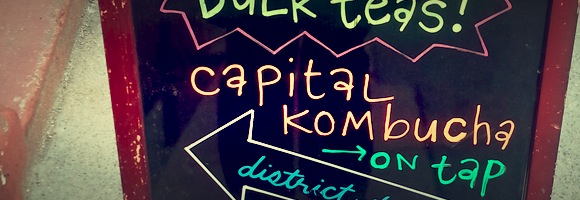
Kombucha (pronounced kom-Boo-cha) seems to be everywhere these days- health food stores, mainstream grocery stores, and District Tea Lodge. The Lodge advertises Kombucha “on draft” and every time I walk by I wondered, what is kombucha anyway?
Turns out kombucha is made from a combination of fermented black tea, sugar, and a mixture of bacteria and yeast. These active cultures are known as SCOBY (“the symbiotic colony of bacteria and yeast”) that, after fermentation, resemble a large pancake or flat mushroom, leading to kombucha’s misnomer as “mushroom tea.”
Although increasingly popular in American markets over the past two decades, kombucha has actually been around for more than 2,000 years, originating in East Asia before being introduced to Europe at the turn of the 20th century.
Kombucha has been associated with incredible health benefits and the ancient Chinese referred to it as the “Immortal Health Elixir.” Those who regularly consume kombucha claim that its benefits include disease prevention, energy improvement, digestion aide, and age inhibitor. Nutritionist Monica Reinagel says that the active cultures found in kombucha “actually live inside of us and help digest our food, digesting particles we can’t digest on our own.” The positive effects of drinking kombucha tea should not be exaggerated however, as Hanna Crum of Kombucha Kamp reminds us that “Kombucha is not a panacea – it doesn’t cure anything! It brings the body back into balance so that it may heal itself naturally. That is how it is able to do so much – because it works with your body’s natural immune system.”
So give it a try and see how it works for you!

